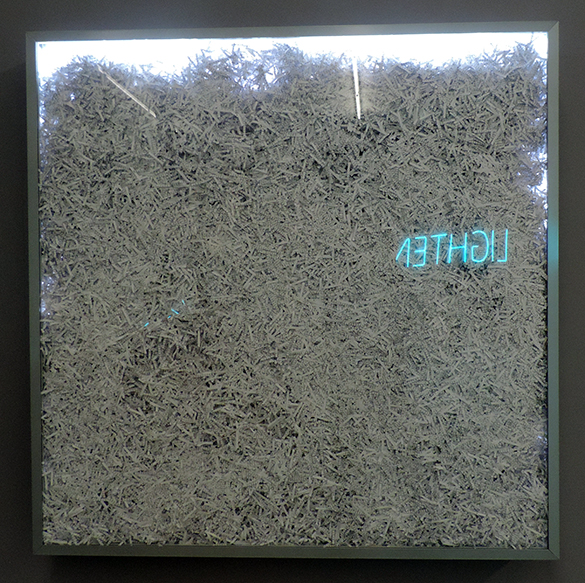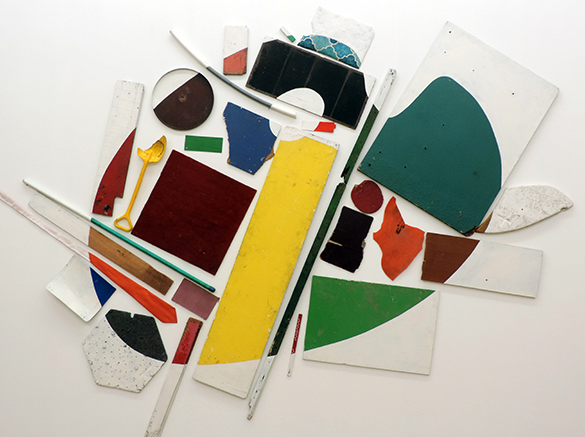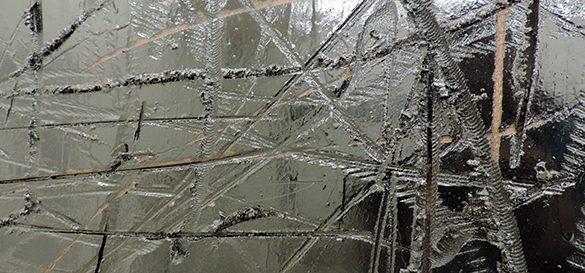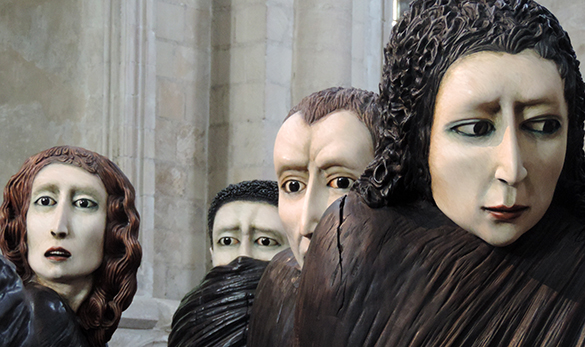Last year we discovered the fabulous 3D work by James Rizzi at Galerie ID. The interest has been phenomenal. He obviously has fans all round the world. We have now been shown his printed “merchandise.” But we’re not talking about posters and tee-shirts. This is quality beautiful stuff from limited-edition Rosenthal ceramics to totally collectable zippo lighters (and a really funky umbrella.) Enjoy our little video!!!
Yearly Archives: 2015
“Public Collections” at Musée Rath
The entrance to Musée Rath gives on to a noisy Place de Neuve in central Geneva. Behind the enormous oak doors, all is calm and quiet. The staff are, as usual, polite and helpful. They and visitors alike communicate in hushed tones. Everything about the place is clean, sobre, sombre and conservative. Exhibitions are always immaculately curated and the current show “Biens Publics” (Public Collections) is no exception.
This eclectic collection of contemporary works celebrates twenty years of Geneva’s prestigious Museum of Modern and Contemporary Art (MAMCO.) No surprise then that the idea for this exhibition came from MAMCO’s charismatic and eloquent director, Christian Bernard. The works on view have been selected from permanent collections of MAMCO, the Museum of Art and History and contemporary art funds of both the City and Canton of Geneva. The first thing that catches my eye is the size, form and ingenuity of Tony Cragg’s “Pallet.”
“Contemporary art” can be difficult to digest if there is no access to the work’s narrative beyond the title. But then, is the person creating or curating the work playing specifically on its indigestibility? Or maybe the viewer should take each work at face value and invent his or her own narrative? Often, questions-to-self do not yield immediate answers. Whatever, there is always a narrative and it’s always interesting. So I just stroll around with an open mind enjoying the narratives – whether untold, whispered or shouted – of some truly innovative and intriguing beautiful stuff. I love the dark story implied by Miriam Cahn’s “Zensur” (Censorship.) Why is a faceless and rather delicate women in a shimmering red dress black-handedly holding down two downcast and defenseless figures?
One room features work by Christian Marclay. He teases us by playing with our senses of vision and hearing; light and sound. I am captivated by his idea of exhibiting a series of photos showing the visual homogeneity of those perforated, sometimes-polished metal plates you hear a reply from – and shout into – when you ring someone’s door bell.

Christian Marclay, “Grand Piano and Mirror” 1994 with (on wall) Christian Marclay, “Rock” “Classic” “New Age” posters, 1994
Here, Marclay has replaced the wires in a grand piano with a mirror. The inside of the lid is mirrored also. The white keys are orange. Whatever he means by this, I find myself walking around it chuckling. I notice five posters on the adjacent wall for what are, at first pass, different concerts. One is for rock, another classical, another for “new age” music etc. Then I notice that the featured musician in every one is none other than the versatile Christian Marclay! Furthermore, all concerts are billed for the same day (28 May) at the same time (19.00) at the same address in Geneva (10, rue des Vieux Grenadiers, Geneva) … that just happens to be the address of MAMCO! What a guy! Bravo, Marclay!

Gianni Motti, “Think Tank” 2014, 500 shredded pages of confidential documents in plexiglass light-box
On the lower ground level, I find Gianni Motti’s “Think Tank.” The concept is arresting. The written outcome of some patently important thought processes lie in a transparent container on full view to the public. But the documents cannot be read… because they are shredded! But how do I know they really were confidential documents in the first place now they are shredded? Motti gets the last laugh.
One room is dedicated to black and white. It is very cool. I pick one work furthest on the right hand wall. It is Imi Knoebel’s massive and energetic ply-wood “Schlachtenbild” (which translates as “battle picture”) .
Just fabulous! Not wishing to cause offense…. I have an image of Jackson Pollock with a machine tool! I admit to a desire to go out and buy a huge ply-wood board, some black paint and an industrial drill even knowing that I would fail in my attempt to produce anything equivalent.
Feeling both animated and challenged, I head for the exit. Christian Robert-Tissot’s provocative “You’ll Thank Me Later” is provocatively positioned just above the door. For what will I later thank the painter? For what will I later thank the curator? I find out in a few seconds. Outside, the traffic bustles, jams and hoots. I thank the Musée Rath for a fascinating couple of hours of reflection in the quiet.
With such an exhibition and the growth of Art Geneve, it seems that Geneva becomes an increasingly important centre for “contemporary art”. Whether or not this is your thing, I recommend a visit to these beautiful, intriguing and even amusing “Biens Publics.”
Ana Maria Pacheco in Norwich
I revisit my school-boyhood by wandering around Norwich Cathedral. The ecclesiastic, stoney-musty ambience evaporates as I turn into the vast building’s north transept. Under those near-one-thousand-year-old single-centered arches I find a sculpture that is beautiful, astonishing and haunting.
I am transfixed by these life-size figures illuminated by stained-glass sunshine. Other visitors stop and stare. I am sure that they too have a torrent of questions in their minds. What does it mean? How was it done? Why is it here? In hushed voice, a man asks his young son “What do you think of that then, Tommy?” After a few seconds of thought, the boy replies “Brilliant!” And it is. But I would love to know what he means by this.
The central piece is a young man stepping forward with the weight of another, sick and fragile man on his back. He is exhausted and might be about to stumble off the crude platform. Both are carved from one piece of wood. Words of a song come to mind: “He ain’t heavy, he’s my brother!”
The other eight figures are also carved in one-piece. They are cloaked in ebony black. The eyes are onyx. The faces are exquisite, multi-ethnic and anxious. One person’s pain is clearly felt by the others. “Shadows of the Wanderer” is about exile, migration, vulnerability and above all fear.
Ana Maria Pacheco was born in Goiana in Brazil in 1943. She witnessed the cruelties and injustices of life under a military junta from 1964. In 1973, on a British Council grant, she won a place to study at London’s Slade. She went on to merit appointment as director of Fine Art at the Norwich School of Art (now the Norwich University of the Arts) from 1985 to 1989. She has exhibited at many of the major institutions in the UK including the British Museum, the Tate Gallery and the Victoria and Albert Museum.
Remaining close to her outraged roots, a central theme in all her work is the abuse of control and power and the vulnerability of the victims. So take a look at what I find when I cross the footbridge to the gallery at the NUA!
Pacheco’s “The Banquet” is grotesque and mesmerising. Four huge, bald, authoritarian men in black are invited to feast on a variety of cruelties about to be inflicted on a pleading and helpless torturee lying prone on the table. The proud host on the left encourages his gleeful guests to tuck in. On the right, the most eager is already rising from his seat with his eyes firmly fixed on the cleft in the poor fellow’s buttocks. This work, sculpted 23 years before, explains the fear and anxiety of “Shadows of the Wanderer.”
I wander around these figures. Again, the lifeful onyx eyes. No one is looking; I place a hand on the shoulder of the host. I feel no unbidden pulse of sadistic energy. But then I recoil with a bizarre mixture of disgust and admiration. Each figure’s mouth has real teeth implanted in its woody gums!
Norwich: a fine city! Ana Maria Pacheco is something of a rare and exotic bird for this very English place. Her technically accomplished work is like nothing else. It incites a tangle of emotions. It is impossible to point at influences. It draws on folklore, biblical myths, carnival, love, family, death and violence. Its human face recalls the amerindian, african and european ethnicities of Brazil. Above all, it is, as young Tommy said, brilliant. Utterly brilliant.
“Shadows of the Wanderer” and “The Banquet” are part of a four-way interlinked exhibition celebrating this versatile sculptor’s work in Norwich. The other locations are Norwich Castle Museum & Art Gallery and the Cathedral of St John the Baptist. Hats off to the curator, Keith Roberts!














